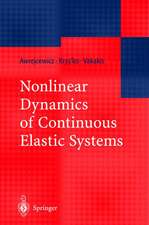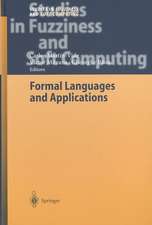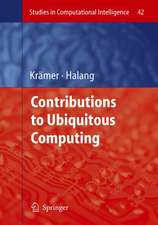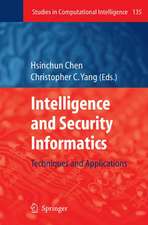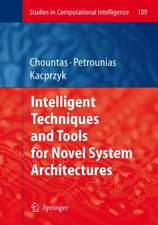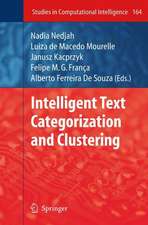Advances in Discretization Methods: Discontinuities, Virtual Elements, Fictitious Domain Methods: SEMA SIMAI Springer Series, cartea 12
Editat de Giulio Ventura, Elena Benvenutien Limba Engleză Hardback – 6 sep 2016
| Toate formatele și edițiile | Preț | Express |
|---|---|---|
| Paperback (1) | 639.59 lei 6-8 săpt. | |
| Springer International Publishing – 12 iun 2018 | 639.59 lei 6-8 săpt. | |
| Hardback (1) | 645.79 lei 6-8 săpt. | |
| Springer International Publishing – 6 sep 2016 | 645.79 lei 6-8 săpt. |
Din seria SEMA SIMAI Springer Series
- 24%
 Preț: 667.60 lei
Preț: 667.60 lei -
 Preț: 281.46 lei
Preț: 281.46 lei - 18%
 Preț: 721.81 lei
Preț: 721.81 lei - 18%
 Preț: 943.25 lei
Preț: 943.25 lei - 15%
 Preț: 630.88 lei
Preț: 630.88 lei - 15%
 Preț: 635.01 lei
Preț: 635.01 lei - 18%
 Preț: 774.83 lei
Preț: 774.83 lei - 15%
 Preț: 632.22 lei
Preț: 632.22 lei - 15%
 Preț: 630.57 lei
Preț: 630.57 lei - 18%
 Preț: 935.21 lei
Preț: 935.21 lei - 18%
 Preț: 937.89 lei
Preț: 937.89 lei - 18%
 Preț: 935.98 lei
Preț: 935.98 lei - 15%
 Preț: 658.88 lei
Preț: 658.88 lei - 15%
 Preț: 630.75 lei
Preț: 630.75 lei - 18%
 Preț: 992.04 lei
Preț: 992.04 lei -
 Preț: 395.47 lei
Preț: 395.47 lei -
 Preț: 386.61 lei
Preț: 386.61 lei - 18%
 Preț: 731.59 lei
Preț: 731.59 lei - 15%
 Preț: 702.73 lei
Preț: 702.73 lei - 15%
 Preț: 648.42 lei
Preț: 648.42 lei - 15%
 Preț: 644.63 lei
Preț: 644.63 lei -
 Preț: 393.52 lei
Preț: 393.52 lei - 15%
 Preț: 645.49 lei
Preț: 645.49 lei - 15%
 Preț: 643.00 lei
Preț: 643.00 lei - 15%
 Preț: 654.77 lei
Preț: 654.77 lei -
 Preț: 385.08 lei
Preț: 385.08 lei - 18%
 Preț: 724.80 lei
Preț: 724.80 lei - 18%
 Preț: 952.40 lei
Preț: 952.40 lei - 15%
 Preț: 636.63 lei
Preț: 636.63 lei
Preț: 645.79 lei
Preț vechi: 759.76 lei
-15% Nou
Puncte Express: 969
Preț estimativ în valută:
123.59€ • 134.20$ • 103.81£
123.59€ • 134.20$ • 103.81£
Carte tipărită la comandă
Livrare economică 22 aprilie-06 mai
Preluare comenzi: 021 569.72.76
Specificații
ISBN-13: 9783319412450
ISBN-10: 3319412450
Pagini: 300
Ilustrații: VIII, 269 p. 133 illus., 97 illus. in color.
Dimensiuni: 155 x 235 x 18 mm
Greutate: 0.57 kg
Ediția:1st ed. 2016
Editura: Springer International Publishing
Colecția Springer
Seria SEMA SIMAI Springer Series
Locul publicării:Cham, Switzerland
ISBN-10: 3319412450
Pagini: 300
Ilustrații: VIII, 269 p. 133 illus., 97 illus. in color.
Dimensiuni: 155 x 235 x 18 mm
Greutate: 0.57 kg
Ediția:1st ed. 2016
Editura: Springer International Publishing
Colecția Springer
Seria SEMA SIMAI Springer Series
Locul publicării:Cham, Switzerland
Cuprins
1 Domenico Notaro, Laura Cattaneo, Luca Formaggia, Anna Scotti and Paolo Zunino: A Mixed Finite Element Method for Modeling the Fluid Exchange between Microcirculation and Tissue Interstitium.- 2 Sandra Pieraccini and Stefano Scialò: On a PDE-constrained optimization approach for flow simulations in fractured media.- 3 Bernd Flemisch, Alessio Fumagalli and Anna Scotti: A review of the XFEM-based approximation of flow in fractured porous media.- 4 Steffen Beese, Stefan Loehnert and Peter Wriggers: Modeling fracture in poly crystalline materials.- 5 C. Gurkan, S. Fernández-Méndez, E. Sala-Lardies and M. Kronbichler: Extended hybridizable discontinuous galerkin (x-hdg) for interface problems.- 6 Yuan Jin, Olivier Pierard, Eric Wyart and Eric Béchet: Crack lip contact modeling based on Lagrangian multipliers with X-FEM.- 7 Thomas-Peter Fries, Markus Schätzer and Samir Omerovic: Stress intensity factors through crack-opening displacements in the XFEM.- 8 Matìas Fernando Benedetto, Stefano Berrone and Andrea Borio: The Virtual Element Method for underground flow simulations in fractured media.- 9 Joe Collis and Paul Houston: Adaptive Discontinuous Galerkin Methods on Polytopic Meshes.- 10 Giulio Ventura and Claudia Tesei: Stabilized X-FEM for Heaviside and Nonlinear Enrichments.- 11 S. Berrone, A. Bonito, M. Verani: An Adaptive Fictitious Domain Method for elliptic problems.- 12 Thomas-Peter Fries, Markus Schätzer, Samir Omerovic: Higher-order accurate integration for cut elements with Chen-Babuska nodes.
Textul de pe ultima copertă
This book gathers selected contributions on emerging research work presented at the International Conference eXtended Discretization MethodS (X-DMS), held in Ferrara in September 2015. It highlights the most relevant advances made at the international level in the context of expanding classical discretization methods, like finite elements, to the numerical analysis of a variety of physical problems. The improvements are intended to achieve higher computational efficiency and to account for special features of the solution directly in the approximation space and/or in the discretization procedure. The methods described include, among others, partition of unity methods (meshfree, XFEM, GFEM), virtual element methods, fictitious domain methods, and special techniques for static and evolving interfaces. The uniting feature of all contributions is the direct link between computational methodologies and their application to different engineering areas.
Caracteristici
Presents advances in cutting-edge technologies for the numerical discretization of physical problems Includes contributions from engineers and mathematicians alike Pursues a more explanatory approach than classical journal papers



